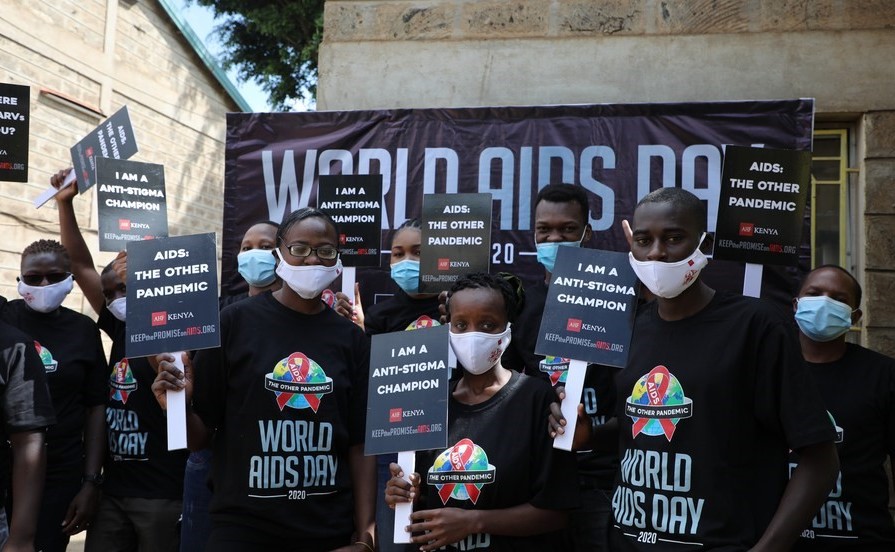


UNAIDS has selected the theme "Global Solidarity, Shared Responsibility" for this year's World AIDS Day. (Xinhua/Fred Mutune)
As we marked the 33rd anniversary of World AIDs Day on December 1, a pandemic caused by a novel coronavirus is sweeping across the globe, overwhelming the medical systems and straining frontline workers.
Amid the COVID-19 crisis, efforts to prevent and control HIV/AIDS both at the community level and inside the rehab centers have faced challenges.
“AIDS follow-up care providers have been the backbone force in the prevention and control of the COVID-19 pandemic,” said Yang Yi, professor at Chengdu University of TCM, “But as health workers at the grassroots level, they also have to provide follow-up care and testing for HIV-infected patients, which can be doubly difficult.”
With social distancing rules, it’s hard to provide such services or reach out to the vulnerable groups for early interventions, and the decrease of outpatients has also hampered the HIV screening programs in the hospital, according to Yang.
As the free treatment of HIV-infected patients is run by local governments, patients left stranded outside of their hometowns by the pandemic could find it hard to get access to needed medicines, a local health worker shared.
“That is exactly why we should contain the coronavirus while continuing to step up our HIV/AIDS prevention and control efforts, including the conventional screening, sentinel surveillance, epidemiological survey, and free treatment of the infected,” said Yang.
Patients with AIDS have had their immune system depleted by HIV, which means they have high demands from the medical service during the COVID-19 pandemic. HIV-infected patients with a drug use history are especially susceptible.
Lei Xiaozheng, head of a project to research the classification management and care relief for drug addicts, pointed out that we should take more care of HIV-infected drug addicts. “Greater efforts need to be taken to carry on classified management and care relief, a mission calling for multidisciplinary collaboration, including law, education, psychology, sociology and management,” said Lei.
During the pandemic, the Sichuan judicial and administrative detox system has set up medical treatment alliances to smooth the technical service channel, enhancing the medical service capability in rehab centers. With the help of remote diagnosis and treatment, patients with a fever, those seeking medical services outside the centers, the number of hospital admissions and outpatients have dropped by 28%, 90%, 78%, and 26% respectively, according to data from the system.
“At present, all medical institutions affiliated with rehab centers in Sichuan have been incorporated into local medical treatment alliances. With this, we can achieve telemedicine, remote teaching, and training,” said An Jia’ai, head of the Sichuan Provincial Drug Rehabilitation Administration.
He also believed that, by conducting online corporations on the diagnosis and treatment of diseases and drug addiction, the basic health and medical needs in rehab centers will be met and their medical services will be greatly improved.
Experts highlight that the philosophy of “prevention first” during the COVID-19 pandemic is a valuable lesson for managing HIV/AIDS.
“During the COVID-19 pandemic, we try to avoid group gatherings or going out, and always put our masks on. That’s prevention upon the prevention,” said Yang Yi, “It is the same case with the HIV/AIDS prevention and control. Prevention is also what we need and it is the best ‘vaccine’.”
The contact tracing methods adopted and the widespread use of nucleic acid testing during the outbreak of COVID-19 have also set a model for future HIV/AIDS management and testing works, according to Yang.
“During this pandemic, a host of laboratories have been built for the nucleic acid testing, which can also be used for the testing of other viruses (including HIV),” said Yang.
Lessons learned during the COVID-19 crisis are conducive to achieving UNAIDS’s “90-90-90 targets”, which aims to diagnose 90% of all HIV positive people, provide antiretroviral therapy (ART) for 90% of those diagnosed and achieve viral suppression for 90% of those treated, by 2020.
Last year, 1.7 million people were newly infected with HIV, marking a 23% decline in new HIV infections since 2010, according to UNAIDS.
“It is the strength within communities, inspired by a shared responsibility to each other, that has contributed in great part to our victories over HIV. Today, we need that strength more than ever to beat the colliding epidemics of HIV and COVID-19,” said Winnie Byanyima, Executive Director of UNAIDS, on World AIDS Day.

 Award-winning photos show poverty reduction achievements in NE China's Jilin province
Award-winning photos show poverty reduction achievements in NE China's Jilin province People dance to greet advent of New Year in Ameiqituo Town, Guizhou
People dance to greet advent of New Year in Ameiqituo Town, Guizhou Fire brigade in Shanghai holds group wedding
Fire brigade in Shanghai holds group wedding Tourists enjoy ice sculptures in Datan Town, north China
Tourists enjoy ice sculptures in Datan Town, north China Sunset scenery of Dayan Pagoda in Xi'an
Sunset scenery of Dayan Pagoda in Xi'an Tourists have fun at scenic spot in Nanlong Town, NW China
Tourists have fun at scenic spot in Nanlong Town, NW China Harbin attracts tourists by making best use of ice in winter
Harbin attracts tourists by making best use of ice in winter In pics: FIS Alpine Ski Women's World Cup Slalom
In pics: FIS Alpine Ski Women's World Cup Slalom Black-necked cranes rest at reservoir in Lhunzhub County, Lhasa
Black-necked cranes rest at reservoir in Lhunzhub County, Lhasa China's FAST telescope will be available to foreign scientists in April
China's FAST telescope will be available to foreign scientists in April